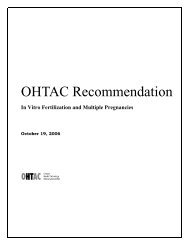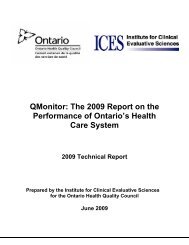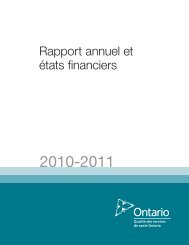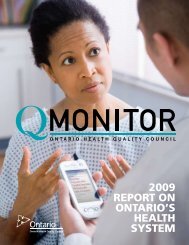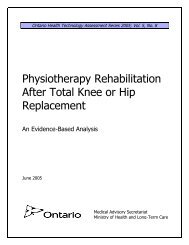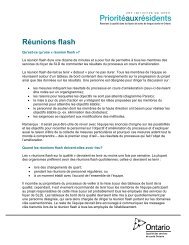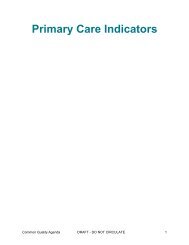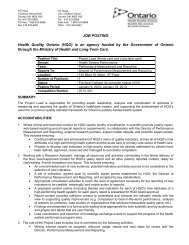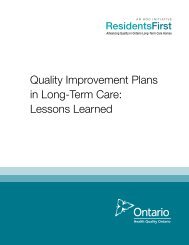Measurement for Quality Improvement - Health Quality Ontario
Measurement for Quality Improvement - Health Quality Ontario
Measurement for Quality Improvement - Health Quality Ontario
You also want an ePaper? Increase the reach of your titles
YUMPU automatically turns print PDFs into web optimized ePapers that Google loves.
0<br />
1 2 3 4 5 6 7 8 9 10 11 12 13 14<br />
Week<br />
Daily Time (Hours)<br />
10<br />
8<br />
6<br />
4<br />
2<br />
0<br />
1 2 3 4 5 6 7 8 9 10 11 12 13 14<br />
Week<br />
Week<br />
A run chart can be used to display any measure over time and is very<br />
easy to develop, requiring not much more than a pencil and paper. Its<br />
simplicity makes the run chart a powerful tool and one of the most useful <strong>for</strong><br />
understanding and communicating variation. Here are some of the reasons to<br />
depict your measures on a run chart:<br />
1. Run charts can help you understand baseline per<strong>for</strong>mance and identify<br />
opportunities <strong>for</strong> improvement<br />
2. They can help you determine if a change is an improvement<br />
3. Once you have made an improvement, you can use the run chart to<br />
determine if you are sustaining the gains you have made<br />
4. A run chart can be used to look at any type of measure over time. For<br />
example: costs, LOS (length of stay), counts, and percentages.<br />
><br />
Scenario Four – An initial<br />
improvement is observed after the<br />
change is made, but in the last<br />
three weeks the process seems<br />
to have returned to its pre-change<br />
cycle time. The results may be due<br />
to a Hawthorne effect, whereby<br />
an initial improvement is observed<br />
due to particular attention to the<br />
measures, but later, when focus<br />
on the change decreases, the<br />
cycle time reverts to the original<br />
process levels. The changes<br />
have not resulted in sustainable<br />
improvement. So the question here<br />
is, given just two numbers, can<br />
you be sure that the process that<br />
produced the second number is<br />
not the same as the process that<br />
produced the first number?<br />
Run Charts to Engage Leadership and Staff<br />
Run charts can also be a powerful tool <strong>for</strong> engaging leadership and staff.<br />
Without a clear picture of the actual outcomes, it is difficult to create a real<br />
desire <strong>for</strong> change or action around an issue. Quite often, staff are shocked<br />
when they are shown the per<strong>for</strong>mance of the organization over time and in<br />
a way that tells a story, which in turn can generate support <strong>for</strong> change. Also,<br />
it is difficult <strong>for</strong> leadership to create the business case <strong>for</strong> investing time and<br />
resources in an initiative without first understanding what the current system<br />
per<strong>for</strong>mance is and perhaps sharing this with a board or management team.<br />
Utilizing run charts to tell the quality story gets everyone on the same page<br />
and clears the path <strong>for</strong> the improvement to begin.<br />
<strong>Measurement</strong> <strong>for</strong> <strong>Quality</strong> Improvment| <strong>Health</strong> <strong>Quality</strong> <strong>Ontario</strong> 13




